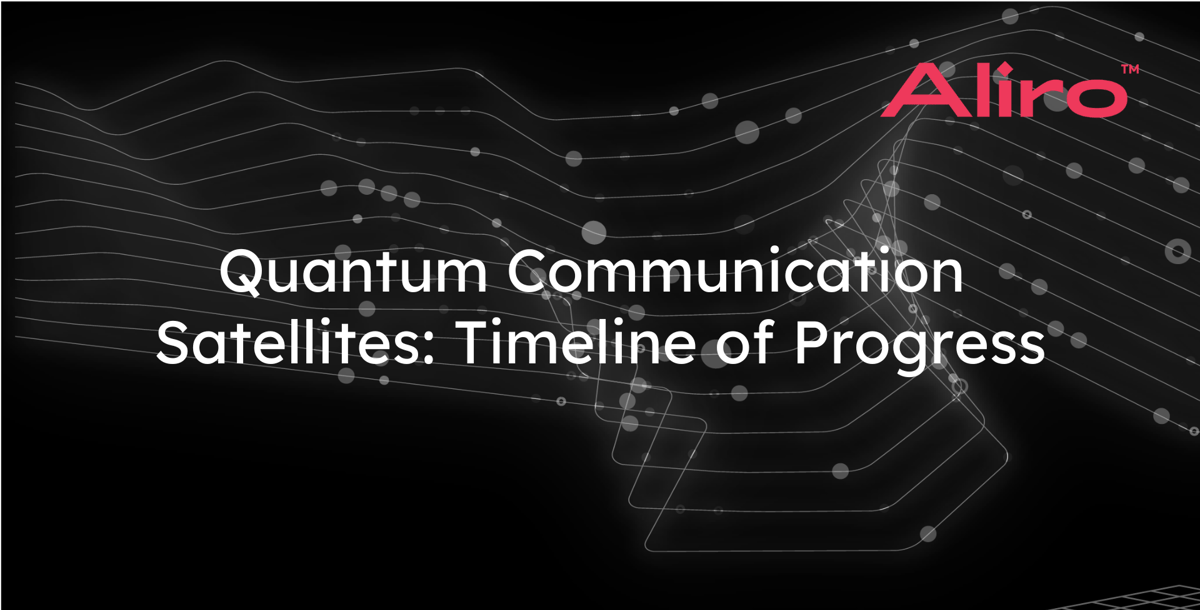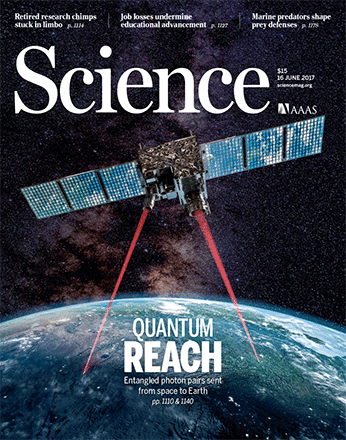
Quantum communication uses the unique properties of quantum entanglement to enable new applications like ultra-secure communication and a new generation of high-performance computing. Today's quantum networks are limited in range. Noise impacts fragile quantum states and causes them to be lost at distances longer than a couple hundred kilometers. On the ground, quantum repeaters can extend quantum networks by building long-range entanglement through a series of hops. Satellites offer a complementary approach by transferring qubits directly through the skies. In this post, we'll review progress towards quantum networks using satellites.
What does a quantum satellite do?
Satellites can be used to establish quantum communication over much longer distances than can be achieved today on the ground. Quantum states such as photons are very fragile. To transfer photons on the ground, they are typically sent along connections in fiber optic cables, the same kind of fiber that is used in today's internet. In fiber, photons are lost to noise very quickly—a distance of a few hundred kilometers. In the air, also known as 'free space,' photons can travel much longer distances before being lost.
Satellites can be used as part of a larger quantum network architecture to connect local ground-based quantum networks across long distances. Connecting networks in this way would build a network of networks, much like today's internet. Satellites offer a near-term approach for building a global quantum network.
Timeline of progress
2015
Six years ago, in 2015, the first signs of feasibility of quantum communication via satellites began to emerge. While satellite quantum communication had not been demonstrated, key components were being developed.
- Entanglement demonstration on board a nano-satellite [Summary]
- Researchers demonstrated entanglement generation on board a satellite for the first time. While entanglement was not extended to Earth, the demonstration showed it was at least feasible to generate entanglement while in orbit. This paved the way for future entanglement-based experiments.
2016-2017
Satellite quantum communication had a breakout year in 2016 and 2017 with the ground-breaking Micius satellite and a series of follow-on experiments. These demonstrations paved the way for the future of satellite-based quantum networks.
- Long-distance free-space quantum key distribution in daylight towards inter-satellite communication
- QKD is demonstrated across free-space on Earth. No satellites were involved in the making of this experiment, but the researchers showed that they could perform quantum key distribution (QKD) across free-space, as opposed to using a direct fiber connection. This is a key step towards satellite communications, since satellites similarly rely on free-space communication.
 Cover of Science magazine in June 2017. Micius satellite makes history.
Cover of Science magazine in June 2017. Micius satellite makes history.
- Satellite-based entanglement distribution over 1200 kilometers
- Suddenly, a global quantum network is within reach. This 2017 paper made history by demonstrating entanglement using a satellite for the first time. Before this experiment, the longest entanglement demonstrations were not longer than hundreds of kilometers. Here, the researchers smashed this recored, showing entanglement across 1,200 km. This experiment, performed in China using the Micius satellite, was one in a series of experiments using the satellite, all of which made significant progress towards global quantum communication.
- Satellite-to-ground quantum key distribution and Ground-to-satellite quantum teleportation
- Following up on their entanglement demonstration, the team led by Jian-Wei Pan used the Micius satellite to show two key applications that are made possible by a quantum communication satellite. First, quantum key distribution (QKD) was shown over 1,200 km, paving the way for long-distance secure communication. Next, quantum teleportation was demonstrated, a key feature needed for practical quantum networks and applications beyond QKD.
2018
- Satellite-Relayed Intercontinental Quantum Network
- Jian-Wei Pan continued to demonstrate leadership in satellite quantum communications, this time demonstrating QKD between China and Austria. Using this link, the researchers showed a QKD-protected conference call. In this case, the satellite acted as a trusted relay, meaning that the security of the communication relies on the assumption that the satellite itself is secure. In future years, the researchers would remove this limitation performing true entanglement-based QKD.
- Towards quantum communication from global navigation satellite system [Summary]
- Most previous demonstrations using satellites have relied on "low-Earth orbit" satellites that orbit the earth at a comparatively closer distance. This closer distance results in lower noise but may have some drawbacks. For instance, a low-Earth orbit satellite only remains visible to a fixed ground station for a short period of time. In this work, researchers showed single-photon communication over 20,000 km using a satellite in the Global Navigation Satellite System (GNSS) network. This showed a proof of concept of using high-orbit satellites and could potentially help secure the GNSS network itself.
2020
- Entanglement-based secure quantum cryptography over 1,120 kilometres
- In their 2017 and 2018 results, Jian-Wei Pan and collaborators showed QKD using the Micius satellite as a "trusted relay." While this allowed for long-distance secure communication, it relied on a crucial assumption—that the satellite itself is kept secure. In this work, the researchers removed the need for a trusted relay, showing entanglement-based QKD between two ground stations separated by 1,120 km at a secret-key rate of 0.12 bits per second. Entanglement-based QKD is a key application of Entanglement as a Service (EaaS) networks, allowing for true physics-based security without the need for trusted relays.
2021
This year, satellite-based quantum communication is moving from the lab to practical networks.
- An integrated space-to-ground quantum communication network over 4,600 kilometres
- Continuing to lead the development of satellite quantum communication, Jian-Wei Pan and collaborators have shown a full integrated QKD network across 4,600 km with a mix of satellite and ground nodes. The network, which uses trusted relays to extend its distance, consists of both a fibre network of more than 700 fibre QKD links and two satellite-to-ground free-space QKD links. In addition to showing integration in a full network, the satellite links achieved higher key rates than previously shown, up to 47.8 kilobits per second for a typical satellite pass.
- U.K. Company plans QKD satellite network in 2023
- Most recently, U.K. company Arqit announced its plans to begin building a QKD network using satellites. The satellites will be launched in 2023 through Virgin Galactic. This marks a transition in satellite quantum communication to the private sector.
To stay up to date with the latest progress in satellite quantum communication and other developments in quantum networks, sign up for the Quantum Connect, Aliro's monthly newsletter, in the footer of this page.
